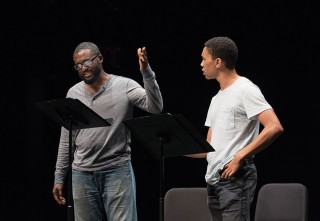Title

Alums Sheldon Woodley and Aaron Moten in playwriting fellow Nathan Alan Davis’s Early's House.
(Photo by Jonathan Tichler) More Photos »Creativity at Juilliard comes in all shapes and sizes. A composer may labor at a desk (a computer keyboard, a piano) for hours and days before a note is played, while a choreographer shapes and edits movement that flows from the limbs and nervous systems of individual dancers. Each creative process is individual and each is collaborative, especially at a school where both creators and performers are growing and changing with teachers and mentors to guide and inspire.
Body
The Artistic Strategy Committee, formed last year, is charged with finding ways for Juilliard dancers, actors, and musicians to work together and learn from one another. One thing all artists have in common is an interest in new work and an eagerness to help bring it to life. In September a new series called Juilliard First Look debuted. At each session—the next one is January 25— student works-in-process are presented, followed by discussions with faculty members, creators, and performers.
First Look #2 took place in October and featured work from all three artistic divisions. It opened with an excerpt of playwriting student James Anthony Tyler’s The Drop Off. In it Allain (played by fourth-year Chelsea Lee Williams) has just moved her mother, Delphina (guest actor Michelle Hurst), to an assisted living facility, and Delphina protests. Afterward Tyler spoke about the play and the process with Richard Feldman, associate director of the Drama Division. Watching the reading, Tyler said, made him realize what was and wasn’t working, and Feldman talked about the trickiness of the rewriting process.
Composition doctoral student Ross Griffey’s Tied by a Chance Bond Together was the second piece of the evening; he wrote it for the performers, first-year master’s violinist Han Shi (BM ’15, violin) and first-year master’s pianist Robert Fleitz (Pre-College ’11; BM ’15, piano). The title comes from Henry Thoreau’s poem Sic Vita, told from the perspective of a bouquet of flowers, which begins, “I am a parcel of vain strivings tied / By a chance bond together, / Dangling this way and that.”
In the piece, the piano and violin are opposing forces at the beginning, then they collaborate, and then it ends with separate cadenzas for each. Griffey, who said he’d known Han and Robert a long time, wanted to mirror their personalities. Composition department chair Robert Beaser noted that the trick to writing for an instrument “is to find its idiomatic core and really let the instrument speak. And when you try to combine instruments that are so different, find some mechanism by which those cores can communicate—albeit, maybe in an adversarial way.”
We closed with What It’s Like, which was choreographed by fourth-year Joe Davis and performed by third-year Caitlin Javech; it was followed by 1000 to 1, choreographed by fourth-year Justin Rapaport and performed by third-year Riley O’Flynn. Davis set What It’s Like to an iconic recording of Maria Callas singing “O mio babbino caro,” and it captures Puccini’s ideas of breath and vocal phrasing in its sweeping lyrical gestures. Rapaport created the choreography for 1000 to 1 from the products of improvisational movement exercises he’d assigned O’Flynn. In one of the exercises, Rapaport asked O’Flynn to alternately imagine his body in a thousand pieces and then as one piece, which inspired the title of the dance. Afterward, the choreographers and performers spoke with Lawrence Rhodes, artistic director of the Dance Division, about the extent to which music inspires their choreography.
First Look #1 featured an excerpt of a new play by playwriting fellow Nathan Alan Davis, a piece for two violins by doctoral candidate Paul Frucht (MM ’13, composition), and a new dance by fourth-year dancer Mason Manning. Come join us at First Look #3, which will feature artists across the divisions as well as stimulating conversation about the infinite directions that creativity at Juilliard can take.









